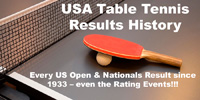July 31, 2017 - Killer Practice Sessions
So you've decided you want to beat the neighborhood or club champ, and move up to the next level. Then you're going to have to practice. You know – go out to the table with another person who's also tired of losing, and do practice drills (not just games) to improve your game. There are a number of factors you should consider to maximize your time. First off, everybody should not be doing the same drills. What drills you should do depend on:
- The playing level of you and your practice partner
- The playing style & equipment of you and your practice partner
- The frequency & duration of your practice sessions
The Playing Level of You and Your Practice Partner
Obviously, if you're just starting out, you won't be working too much on your inside-out loop off the bounce. On the other hand, you won't see the world champion hitting forehand to forehand much except as part of a short warm-up. So choose drills that are appropriate to your level. Focus on consistency and proper form. Move your feet to every shot and return to ready position. Get the fundamentals down so you will be "good enough" to do advanced drills with shots you can actually do in a match consistently. Without the fundamentals, your game will always be fundamentally flawed, and it will be difficult to improve.
Playing Styles & Equipment of You and Your Practice Partner
The playing style of you and your partner also affects what drills you will be doing. If your partner has long pips on his backhand, don't expect to practice rapid-fire backhand to backhand type drills. If one player is primarily a looper, the other a hitter, then each will be doing different style drills. So you have to make allowances for all of this. Take advantage of your partner's style to practice drills against that particular style. To become a well rounded player try to practice against a wide variety of styles, especially prior to tournaments.
The Frequency and Duration of Your Practice Sessions
If you only practice occasionally, you should pick your drills with great care. There are two "theories" as to how to choose drills for an occasional practice session. You can either choose specific parts of your game that need work, and focus on that; or you can do a general session, working on your most common shots. Here's our recommendation: choose a couple of things that you really need work on; choose a couple of things that you do really well, and want to tune up; and work these items into a general practice session that covers as many of the techniques that you use in a match as possible.
Of course, if you practice regularly, you'll get the best of both worlds.
Choosing the Drills for Your Practice Session
There are many possible models for a practice session. What we are going to do is design a general session that you can use as a model for yourself. Each part of the practice session developed below is divided into beginning, intermediate and advanced drills. The level designation does not refer strictly to your overall level of play, however. Take into account how well you do the technique being practiced. For example, a player with a good loop may do more advanced looping drills than a stronger player whose loop is not as good. Using the USATT's rating system, a very rough idea of these levels might be up to 1300 for beginner level, from 1300-1800 for intermediate, and 1800+ for advanced.
When you read the drills below, it is important to remember that the drills are not carved in stone. For example, if a drill calls for you to hit the ball to your partner's backhand, you can change the drill and hit to his forehand instead. This is simply how one session and set of drills could go. When we say to hit a particular shot with, say, a forehand, that means either a forehand drive or a forehand loop, depending on your playing style. (The drills assume both players are right-handed; left-handers should adjust accordingly.)
As you get better with some drills, you should make them more like a match. For example, when doing a side-to-side footwork drill, instead of starting off with a topspin serve and getting right into the drill, start off the drill with a backspin serve, have your partner push it back, and loop the first ball. Your partner would block it back, and you'd then continue the drill as a footwork drill. Or you might start a drill with a sidespin serve, with the receiver topspinning it back, and then go into the footwork drill. In most of the drills listed here, this type of drill is not listed or the listings would simply get too long and complicated. We leave it to you to incorporate this into some of the drills below – but only after you are consistent with the drill as it is.
A typical practice session might be broken down into the following eight parts. Missing any part is like missing a link in a chain, so incorporate all parts in your session in some way.
- Warm up/stroking drills
- Footwork drills
- Attack drills
- Break
- Serve & Receive drills
- Specialized drills
- Match play
- Solo practice
Warm Up/Stroking Drills:
This is where you warm up the muscles and tune up the basic shots. Beginners need to do more basic stroking drills, such as forehand to forehand and backhand to backhand, to develop the strokes and the timing. As players get more advanced, more advanced techniques should be incorporated into the warm-up, such as looping or footwork practice (which overlaps the next part of the practice session).
Beginners
- Forehand-to-forehand, crosscourt, or forehand to backhand, down the line, 7.5 minutes
- Backhand-to-backhand, crosscourt, or forehand to backhand, down the line, 7.5 minutes
- Backhand-to-backhand pushing, 5 minutes
- Forehand-to-forehand pushing, 5 minutes
Optional drill:
- See how many forehands and backhands you can hit in a row. Try for 100 or more.
Intermediate
- Forehand-to-forehand, crosscourt, 2.5 minutes
- Backhand-to-backhand, crosscourt, 2.5 minutes
- Forehand-to-backhand, down the line, 2.5 minutes
- Backhand-to-forehand, down the line, 2.5 minutes
- Forehand loop against block, 5 minutes each
Optional drills:
- Pushing all over table, all types of pushes
- Backhand loop against block
- Counterlooping
Advanced
- Forehand-to-forehand crosscourt or forehand to backhand down the line, 2.5 minutes
- Backhand-to-backhand, crosscourt or backhand-to-forehand, down the line, 2.5 minutes
- Forehand loop against block, partner moves you around, 5 minutes each
- ptional drills:
- Backhand loop against block
- Counterlooping
- Pushing all over table, all types of pushes
Footwork drills:
Beginners
- Alternate forehand and backhand shots. You hit all shots to one place on partner's side, either the forehand or backhand side. Partner alternates hitting to your forehand and backhand corners. 5 minutes each
- Side-to-side forehand footwork, all forehands against partner's backhand block to your forehand and backhand courts, 5 minutes each
- Optional drill:
- Figure 8 footwork, you hit every shot crosscourt while your partner hits every shot down the line, 5 minutes each then change direction
Intermediate
- Side-to-side footwork drill, 2/3 table covered, 7.5 minutes each
- Partner randomly hits ball either to your forehand or backhand side; you stroke each ball back to the same spot. 5 minutes each
Optional drills:
- See Falkenberg drill under "advanced."
- Figure 8 FH footwork – server goes crosscourt, receiver goes down the line with both players only using forehands. 10 minutes total.
Advanced
- Side-to-side footwork drill, fast, 2/3 to full table covered, 5 minutes each
- 2-1 drill (also called Falkenberg drill): You hit all balls to your partner's backhand. He hits two to your backhand, one to your forehand, then repeats. You return first shot with your backhand, step around and hit next with your forehand, then return the next shot (to your wide forehand) with your forehand. 5 minutes each
- Random footwork. Partner hits balls to all parts of the table randomly; you stroke each ball back to the same spot. 5 minutes each
Optional drill:
- Serve backspin; partner pushes to your wide backhand; you step around and loop with your forehand to your partner's forehand; he quick-blocks crosscourt to your wide forehand; play out the point.
Attack drills:
Beginning
- Serve backspin; partner pushes ball back to specified part of table; you loop, and play out the point. 7.5 minutes each.
Optional drill:
- Serve fast & deep to partner's wide backhand, follow up with aggressive forehand or backhand hit or smash
Intermediate
- Serve short backspin; partner pushes ball back to specified part of table; you loop, and play out the point. 5 minutes each
- Serve short backspin; partner pushes ball back randomly anywhere; you loop (forehand from forehand side, backhand from backhand side), and play out the point. 5 minutes each.
Optional drill:
- Serve fast & deep anywhere on the table, follow up with a loop
Advanced
- Serve short backspin; partner pushes ball back randomly anywhere; you loop (forehand from forehand side, forehand or backhand from backhand side), and play out the point. 7.5 minutes each.
Optional drills:
- Server has option of an occasional sudden fast & deep serve to mix things up. Or receiver has option of attacking the serve occasionally. There are many ways of varying this drill.
- Serve short sidespin to partner's forehand. Partner flips serve to wide angle. You loop or hit, and play out point.
Break (5 minutes?)
Serve & Receive drills:
Beginning
- Practice any serve, at least one minute for each serve. This way you not only get to practice and develop the serve, but your partner (and then yourself) gets to practice receiving it. 7.5 minutes each
Intermediate
- Practice serve and attack. Server can use any serve, but must follow up aggressively. Receiver may attack any deep serves, but should emphasize control. Alternate drill: Server serves one type of serve over and over, receiver is given two options for receive. Server must prepare for both. 7.5 minutes each
Advanced
- At this point, serve and receive drills get complicated. Advanced players should pick any serve & receive pattern, and practice it. For example, consider all the possible patterns starting with the server serving short backspin, topspin, no-spin, or sidespin. Receiver can push long or short or flip to either side or to the middle. In most drills, receiver should have two possible options, and server must prepare for both.
Specialized drills:
At this point, drills becomes too personalized to really plan a session without knowing the players. However, here are some of the things you might want to practice, depending on the styles, levels, weaknesses and strengths of you and your partner. Choose two drills, and each player gets 7.5 minutes for each drill.
- Backhand loop (this can also be done during warm-up).
- Loop/chop drill. Drill is done either all crosscourt or all down the line. You loop; partner blocks; you chop; partner pushes; you loop, and drill repeats. This is especially good for developing the backhand loop versus backspin.
- Hitting or smashing against block
- Lobbing or chopping
- Looping against a chopper
- Counterlooping
- Any of an infinite number of serve & receive drills.
Match play:
Regardless of your level, you need match practice to try out what you do in practice. All the practice on a technique is pointless if you aren't able to do it in a game situation! So most practice sessions end with a practice match.
One way to make the practice match even better is to assign "styles" to the players. For example, one player may be designated the aggressor in one game, while the other plays a mostly steady blocking or counter-driving game (but attacking when the shot is there). Or one player may try pushing and blocking one game, while other player plays mostly looping.
If you and your partner are not really the same level, you might play games with the stronger player spotting points. Each game the spot changes by one, depending on who won the previous game. Playing deuce games can also be very helpful.
Solo Practice:
There are three types of practice you can do by yourself, outside your regular practice session.
First, there is serve practice. Although there were a serve/receive drills in the session designed here, this isn't enough. You really need to find the time to practice your serves, perhaps twice a week for 15-20 minutes – more, if you really want to be good!
Second, if you really want to improve to a high level, you should do some physical training. Jumping rope, wind sprints, distance running, pushups, sit-ups and weight training are all excellent physical training for table tennis. You use nearly the entire body for table tennis, so you need to train nearly the entire body. Stretching is also valuable in that it prevents injuries, shortens recovery time between training sessions, and general flexibility helps you play better.
Lastly, learn something about mental training. Here are some great resources.





